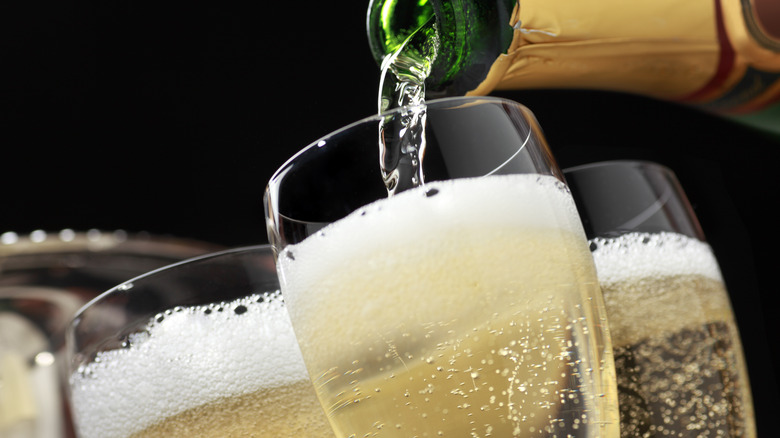What's The Difference Between Force-Carbonated And Traditional Sparkling Wine?
Who doesn't like a flute full of bubbles? With its fizzy character and often gentler taste, sparkling wine delights drinkers. Unlike the protected Champagne name, sparkling wine is a label that encompasses all, only necessitating that the wine contains carbonation. As a result, the celebratory bubbly beverage comes in many different types, with variations of white and rosés produced in nearly all wine-making regions, as well as a few that produce effervescent reds.
So it's no surprise that numerous methods exist for achieving its captivating sparkling quality. Techniques have evolved over the centuries, employing many different fermentation procedures. Each style creates not only varying flavors but also textures.
Of all the creation methods, few contrast more than forced carbonation and the traditional method of getting bubbles into booze. The former is a modern invention that artificially injects carbon dioxide gas into wine. Meanwhile, the latter technique bottles a still wine and ferments it a second time alongside a yeast-based solution. Both create delicious sparkling wine expressions, each with its own advantages.
What is force-carbonated sparkling wine?
Force carbonation is a relatively new technique, first invented by British chemist Joseph Priestley in the 18th century. He didn't commercialize the process, however, that was down to one Johann Jacob Schweppe, who realized its potential when he set up the Schweppes Company in 1793. Today, force carbonation is the process of choice for most bubbly drinks that aren't wine and beer; it's how sodas, carbonated waters, and the whole range of hard seltzers all attain their carbonation.
The process for sparkling wine using this method is fairly straightforward. Still wine, which has already fermented to its final state, is cooled until nearly frozen, enabling improved gas absorption. Carbon dioxide is then pumped from a tank into the wine using a valve. The wine is carbonated to a specific pressure, which tends to be higher than sodas and other sparkling beverages.
With forced carbonation's ease and speed, this wine-making style is associated with affordable, low-quality bottles. However, that's not a steadfast correlation; new winemakers are using the method to craft innovative sparkling wines that aren't possible with other techniques. Plus, it's a more accessible process for home brewers and small operations, enabling micro-batch creations.
What is traditional sparkling wine?
The traditional method is used for some of the most beloved sparkling wines worldwide. Especially intertwined with all types of Champagne, where the méthode Champenoise is protected by law, it's also how cava, quality English bottles of fizz, beloved Italian specialties like Col Fondo prosecco, and many New World sparkling wines from North America, Australia, and South Africa are crafted.
The wine-making technique involves two fermentation processes. The first yields a still wine, which is transferred to the final bottle. It's then mixed in with a solution called liqueur de tirage, consisting of more yeast, sugar, and sometimes a small pour of wine.
The secondary fermentation creates the wine's bubbly nature, with carbon dioxide gas forming inside the bottle. The alcoholic content only slightly increases, but a dead yeast sediment called lees accumulates. The lees thicken the mouthfeel and add a pleasing bready roundness. The bottle is rested, with frequent rotation, to get all the lees into the neck of the bottle, before the debris is removed.
The result is then finished with the addition of more wine and sugar before a final rest. Altering ratios, as well as cellaring duration, allow a producer to craft several varieties from a single base.
Traditional sparkling wines offer complexity
The traditional method is intricate, with factors like the base wine, yeast, added ingredients, and cellaring period all contributing to the flavor. Throw in the fact that the second fermentation occurs in the bottle — unlike in a larger tank with wines like prosecco — and it becomes clear why such wines are so esteemed, and why there's a difference between Champagne and prosecco. Each step is laborious but invokes complexity impossible with force-carbonated sparkling wines.
For example, the lees, which occur during the second fermentation, create rich flavors absent in force-carbonated wines. And this wine stage also leads to a distinct texture. The carbonation holds many small bubbles, felt in every sip of wine. This mouthfeel is unique to the process.
In the traditional method, wines also go through several wine additions, which imbue complexity during numerous stages. Meanwhile, force-carbonated wines are restricted to single-fermented wine bases, diminishing flavor possibilities. Although tasty and fascinating, these are the factors that contribute to the steeper prices associated with the traditional method.
Force-carbonation opens sparkling wine possibilities
With a delicate and storied creation process, traditional sparkling wines typically fit a classic palate. Often upheld by legal regulation for a denomination of origin, they follow a rigid creation process. Plus, their creation method carries limitations. It's difficult to create sweet wines with the process, since the sugars quickly ferment into the yeast. And the palate and carbonation levels are also far more difficult to control.
Forced carbonation enables precise control of carbon dioxide levels. The wine texture can be easily manipulated and matched to the grapes utilized during production. Additionally, the alcohol level is more malleable, enabling low-ABV creations more easily. And there is the price aspect; delicious bottles of fizz become more accessible. So, while this wine-making style may comprise some bottles reserved as the most affordable option, it's not only about lower-quality offerings. From rieslings to California blends, new and exciting force-carbonated sparkling wines are expanding the market.




